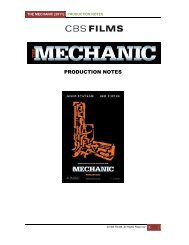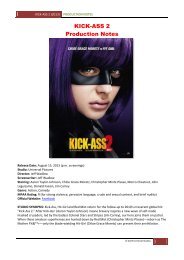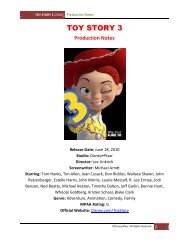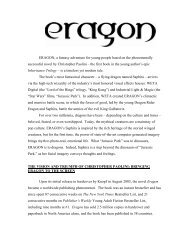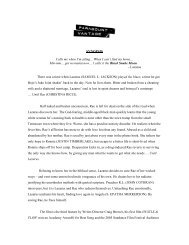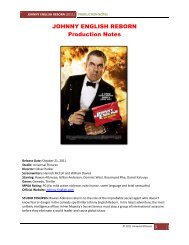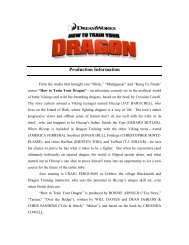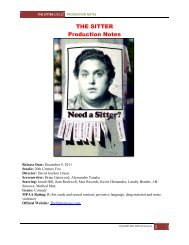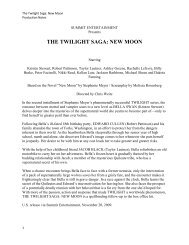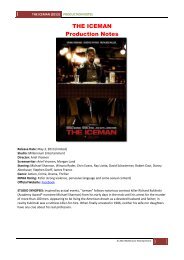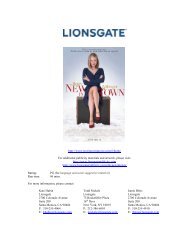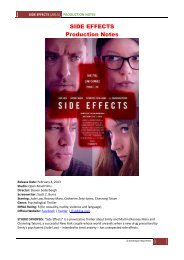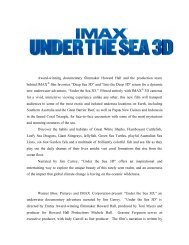"Cloud Atlas" production notes [PDF] - VisualHollywood
"Cloud Atlas" production notes [PDF] - VisualHollywood
"Cloud Atlas" production notes [PDF] - VisualHollywood
You also want an ePaper? Increase the reach of your titles
YUMPU automatically turns print PDFs into web optimized ePapers that Google loves.
CLOUD ATLAS (2012) PRODUCTION NOTES<br />
we try to show the audience things they haven't seen before; emotionally, we try to offer enough<br />
thrills or action or romance to satisfy the kid in us as well as the audience; and, finally, we try to<br />
offer new perspectives or thoughts about very personal issues or ideas relevant to our everyday<br />
lives."<br />
"That's what drew me originally to Andy and Lana's work, the conviction that you can engage the<br />
heart and the mind simultaneously," states Tykwer. "You can have this fusion engine of intriguing<br />
issues to talk about, and yet, while watching it, you're just blown away."<br />
FROM BOOK TO SCREEN: MAKING THE CONNECTIONS<br />
"Listen close and I'll yarn you 'bout the first time<br />
we met eye to eye..." – Zachry, 2346<br />
The opportunity to bring audiences a tale of this magnitude was irresistible to the Wachowskis and<br />
Tykwer. But, how? Mitchell presented his story as a series of opening acts whose plots reach a climactic<br />
halfway point, stop, and are then resolved one by one. "We knew we couldn't make that<br />
structure work for a film," Lana recalls. "But it made us think about the possibilities of expanding<br />
the confines of a standard cinematic narrative."<br />
Mitchell gave each chapter its own genre "to make the parts different enough so the stylistic color<br />
of one doesn't bleed into another," he says. "I thought of it as a menu with courses from different<br />
cuisines." This construct the filmmakers gladly adopted, making one segment primarily a drama,<br />
one a romance, and still others a crime thriller, a comedy, and a futuristic sci-fi adventure.<br />
Yet the power of "<strong>Cloud</strong> Atlas" is not the ways in which these elements diverge, but in how they<br />
weave seamlessly into what Andy calls "a mosaic. As you go from scene to scene, you are creating<br />
that mosaic in your head. You are automatically finding the associations between them. So we intuitively<br />
went in that direction for the film."<br />
Distilling scenes and relationships from the book onto index cards, the filmmakers then spent days<br />
organizing them into groups and arrived at a more direct interlacing of storylines. Says Andy,<br />
"When you're staring at these hundreds of cards, you see the characters side by side and naturally<br />
gravitate toward the points where they have similar arcs, or how one picks up where another has<br />
finished."<br />
"Our goal was to develop a meta-narrative to bind everything together into one flowing story with<br />
its own momentum," Tykwer explains.<br />
Exploring the novel's motifs of eternal recurrence allowed for haunting déjà vu moments of recognition<br />
when characters meet seemingly for the first time, yet feel they know each other, or the <strong>notes</strong><br />
of a symphony ring familiar to a music store clerk who might have been the person who composed<br />
it a lifetime ago.<br />
Toward that end, the filmmakers expanded on Mitchell's device of a comet-shaped birthmark on<br />
certain characters to indicate the migration of a single soul. "In the novel," says Mitchell, "the comet<br />
birthmark insinuates that it's the same character being reborn over time...a soul crossing through<br />
eternity, shifting its form."<br />
On screen, that rebirth is represented instead by the visual through-line of actors reappearing in one<br />
© 2012 Warner Bros. Pictures 6


!["Cloud Atlas" production notes [PDF] - VisualHollywood](https://img.yumpu.com/7420477/6/500x640/quotcloud-atlasquot-production-notes-pdf-visualhollywood.jpg)
